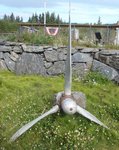Pete_Homer_AK
Airman
- 35
- Sep 14, 2012
Hi,
While surfing the web for information on our mystery prop I came upon a posting from a D. Hutchinson who worked for a company that did cleanup work on Amchitka Island over a decade ago. The company, Chris Berg Inc, was under contract to the US government. They brought the mystery prop back to Homer along with a lot of other salvage material, most of which went to the local dump. The prop was saved and put on display outside the Alaska Islands and Oceans center in Homer.
An important fact from this post is that some years earlier Jim Coffey, an employee of the government stationed on Amchitka, found the prop and set it up near the airport. One could assume he discovered the prop in an aircraft grave yard on the island. Apparently there was a lot of material left over from the war. If you check out the link to aircraft accident reports
on Amchitka in a previous post you will see that there were about 75 crashes, most at the height of the effort to take Kiska and Attu Islands back from the Japanese in 1943. Due to the remote location, many of those wrecks were written off and left on the island.
It would be great to ask Jim Coffey how he found the prop and what aircraft might have been in the area but... (sigh)I haven't been able to locate him on the internet. He also had his wife, Nancy Coffey, and daughter Tiffany Coffey along and they might be able to contribute to the history of our prop. It would be interesting to talk to D. Hutchinson to see if he could add information on the retrieval process. I believe he lives in Anchor Point, AK about 20 miles north of Homer, but again I failed to locate him.
Here is link to the site Amchitka Scrapbook Post which includes a remarkable photo of our mystery prop. near the air terminal on the Island way back in the late 1970's.
The mystery slowly unfolds...
Pete

Mystery prop near Amchitka terminal 1975-78
While surfing the web for information on our mystery prop I came upon a posting from a D. Hutchinson who worked for a company that did cleanup work on Amchitka Island over a decade ago. The company, Chris Berg Inc, was under contract to the US government. They brought the mystery prop back to Homer along with a lot of other salvage material, most of which went to the local dump. The prop was saved and put on display outside the Alaska Islands and Oceans center in Homer.
An important fact from this post is that some years earlier Jim Coffey, an employee of the government stationed on Amchitka, found the prop and set it up near the airport. One could assume he discovered the prop in an aircraft grave yard on the island. Apparently there was a lot of material left over from the war. If you check out the link to aircraft accident reports
on Amchitka in a previous post you will see that there were about 75 crashes, most at the height of the effort to take Kiska and Attu Islands back from the Japanese in 1943. Due to the remote location, many of those wrecks were written off and left on the island.
It would be great to ask Jim Coffey how he found the prop and what aircraft might have been in the area but... (sigh)I haven't been able to locate him on the internet. He also had his wife, Nancy Coffey, and daughter Tiffany Coffey along and they might be able to contribute to the history of our prop. It would be interesting to talk to D. Hutchinson to see if he could add information on the retrieval process. I believe he lives in Anchor Point, AK about 20 miles north of Homer, but again I failed to locate him.
Here is link to the site Amchitka Scrapbook Post which includes a remarkable photo of our mystery prop. near the air terminal on the Island way back in the late 1970's.
The mystery slowly unfolds...
Pete
Mystery prop near Amchitka terminal 1975-78
Last edited:

